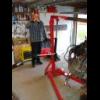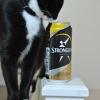The correct way to do it is with the engine at proper operating temperature (80 Grad C)with the throttle wide open.
Do you use a screw-in tester? All sparks out? Throttle fully open?
A teaspoon of oil in the cylinder to be tested should improve pressure.
If not --->valve problem or gasket problem.
Here an extract from a magazine:
- If there is any serious variation, you can try a few other tricks to attempt to discover the cause
o First, set your valve clearances (12 thou cold), then retest
o Second, run the test with all of the spark plugs removed -- if there is a drastic difference between plugs in and plugs out, you may have a gasket blown between cylinder
o Third, if one or more cylinders is lower than the others try squirting a bit of oil (no more than a teaspoon) into the cylinder and retesting, if the pressure increases you may need new rings, if it stays low it may be a gasket, a sticky or burnt valve or a poorly seating valve
- Other things to look for are bubbles in the coolant while running (take off the radiator cap, top up the coolant, start the car and watch for bubbles. A few is normal, and the car may eventually bump some coolant out when it warms up fully, also normal
- A steady stream of bubbles or dropping coolant level are signs of a bad gasket or cracked head
- Also, check for oil in the coolant (black floating globs) or coolant in the oil (pop the oil fill cap off and look for white, milky goop, a little is to be expected from condensation, a lot is bad)
Compression testing and ratios
A compression gauge tells you what pressure it sees in the combustion chamber when the engine is being driven by the starter motor.
The first problem is that compression gauges are not precision devices nor are they intended to be. They are only good for relative measurements.
A good way to test a compression gauge is to measure the same cylinder several times over a period of time and see how the measurements change. Second, a cold engine, driven by a starter motor isn't a great approximation of an operating engine. The cam can have large effects on the numbers as can the cranking speed. This is why using a compression gauge to estimate compression ratio is likely to be inaccurate.
However, one table of CR and pressures comes with the following warning: "Just to satisfy the reader's curiosity, below is a table showing the approximate relationship between compression ratio and compression pressure at cranking speeds. However, even if a table such as this could be trusted, there is the question of gauge accuracy." (Motor's Auto Engines and Electrical Systems c.1970)
Edited by Alpenflitzer, 09 April 2016 - 03:13 PM.

















